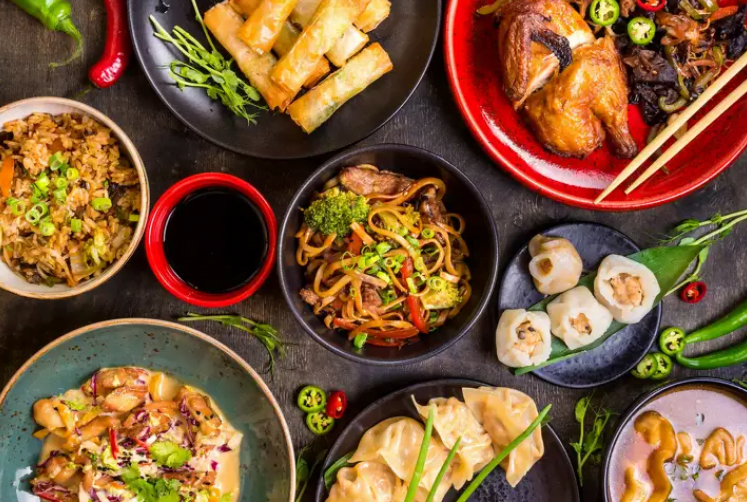Chinese Food: Exploring the Rich Flavors of Chinese Cuisine


Introduction
Chinese food is renowned worldwide for its diverse flavors, aromatic spices, and exquisite culinary traditions. From mouth-watering stir-fries to delicate dim sum, Chinese food offers a delightful experience that tantalizes the taste buds. In this article, we will take a captivating journey through the vibrant world of Chinese cuisine, exploring its history, regional variations, popular dishes, and the cultural significance of food in Chinese society.
1. History of Chinese Food
Chinese food boasts a rich history that spans thousands of years. It has evolved through dynasties and centuries, influenced by various factors such as geography, climate, agriculture, and cultural traditions. Ancient Chinese cooking techniques and recipes were documented in culinary texts, such as the “Yinshan Zhengyao,” dating back to the Tang Dynasty. The cuisine flourished during the Ming and Qing dynasties, with the development of elaborate banquet traditions.
2. Regional Variations
China’s vast territory encompasses diverse regions, each with its unique culinary style and flavor profiles. The eight major regional cuisines include Cantonese, Sichuan, Shandong, Jiangsu, Fujian, Hunan, Zhejiang, and Anhui. Each region has distinct ingredients, cooking techniques, and flavor combinations, reflecting the local culture and geography.
3. The Influence of Chinese food on Global Food Culture
Chinese cuisine has made a significant impact on global food culture. Its popularity can be witnessed in the proliferation of Chinese restaurants worldwide and the incorporation of Chinese flavors and techniques into various international cuisines. The introduction of staple Chinese ingredients like soy sauce, tofu, and noodles has transformed the way people cook and enjoy food across the globe.
4. What are popular Chinese foods?
4.1 Dim Sum: A Gastronomic Adventure
Dim sum refers to a variety of bite-sized dishes traditionally served in small steamer baskets. This Cantonese specialty offers a wide array of dumplings, buns, rolls, and savory pastries, often enjoyed with a cup of fragrant Chinese tea. From the delicate shrimp dumplings (har gow) to the flavorful BBQ (char siu bao), dim sum presents a gastronomic adventure that showcases the artistry and flavors of Chinese cuisine.
4.2 Peking Duck (China’s National Dish): A Symbol of Chinese Culinary Excellence
Peking Duck is a beloved Chinese dish known for its succulent roasted duck with crispy skin and is considered among the best Chinese food dishes. Originating from Beijing, this dish has a history dating back to the Imperial era. The duck is carefully prepared, marinated, and roasted until the skin becomes golden and crispy. It is often served with thin pancakes, scallions, cucumber, and hoisin sauce, allowing diners to wrap the tender duck slices in a delightful combination of flavors.
4.3 Mapo Tofu: Spicy and Flavorful Sichuan Delight
Mapo Tofu is a classic Sichuan dish that combines soft tofu cubes, ground pork, and a fiery chili and bean-based sauce. This flavorful and spicy dish is renowned for its “ma la” sensation, which refers to the numbing and spicy flavors that Sichuan cuisine is famous for. Mapo Tofu is a perfect representation of the bold and robust flavors that characterize Sichuan cuisine.
4.4 Xiaolongbao: Delicate Soup Dumplings
Xiaolongbao, also known as soup dumplings, is a Shanghai specialty that has gained worldwide popularity. These delicate dumplings are filled with a savory mixture of minced pork and a rich, flavorful broth. When steamed, the broth turns into a luscious soup encased within the thin dumpling wrapper. Xiaolongbao is enjoyed by carefully biting into the dumpling, savoring the explosion of flavors and textures.
4.5 some other popular dishes include
- Kung Pao Chicken.
- Chow Mein.
- Chinese Hot Pot.
- Spring Rolls.
- Wonton Soup.
5. Chinese Cooking Techniques
Chinese food employs various cooking techniques that contribute to its distinct flavors and textures. Here are three notable techniques:
5.1 Stir-Frying: The Art of Quick and Flavorful Cooking
Stir-frying is a popular cooking technique that involves quickly cooking ingredients in a hot wok or skillet. The high heat and constant stirring create a unique smoky flavor while preserving the natural colors, textures, and nutrients of the ingredients. Stir-frying allows for endless combinations of vegetables, meats, and sauces, resulting in vibrant and flavorful dishes.
5.2 Steaming: Retaining Nutrients and Enhancing Flavors
Steaming is a gentle cooking method that preserves the natural flavors and nutrients of ingredients. It is commonly used for preparing delicate fish, dumplings, and vegetables. Steamed dishes are light, healthy, and showcase the freshness and quality of the ingredients.
5.3 Braising: Slow-Cooking for Tender and Flavorful Results
Braising involves cooking ingredients slowly in a flavorful liquid, often a combination of broth, soy sauce, and aromatic spices. This method tenderizes tougher cuts of meat and infuses them with rich, savory flavors. Braised dishes are hearty and comforting, with the meat becoming tender and succulent.
6. The Cultural Significance of Food in Chinese Society
Chinese culture places great importance on food, considering it not only as nourishment but also as a reflection of social connections, traditions, and auspicious symbolism. Here are two aspects highlighting the cultural significance of food:
6.1 Symbolism and Superstitions
Food symbolism is deeply ingrained in Chinese culture. Certain dishes and ingredients are associated with good luck, prosperity, and auspicious occasions. For example, fish symbolizes abundance and prosperity, while noodles signify longevity. Additionally, certain foods are avoided during specific occasions due to superstitious beliefs.
6.2 Festivals and Celebrations
Chinese festivals and celebrations are marked by an abundance of Chinese food, emphasizing the importance of communal dining and shared experiences. During festivals such as Chinese New Year and the Mid-Autumn Festival, families gather to prepare and enjoy traditional dishes that hold cultural significance. These celebrations foster a sense of unity and reinforce familial ties.
7. Health Benefits of Chinese Food
Chinese food embraces a balanced approach to food, emphasizing fresh ingredients, proper cooking techniques, and harmony between flavors. Here are three health benefits associated with Chinese cuisine:
7.1 Balanced and Nutritious Ingredients
Chinese dishes often incorporate a variety of vegetables, lean proteins, and whole grains, providing a well-rounded and nutritious meal. The emphasis on seasonal produce ensures that meals are packed with vitamins, minerals, and dietary fiber.
7.2 Traditional Chinese Medicine and Healing Foods
Traditional Chinese Medicine (TCM) has a strong influence on Chinese culinary practices. Many ingredients and herbs used in Chinese cuisine are believed to have medicinal properties and promote overall well-being. For example, ginger is used to aid digestion, and goji berries are known for their antioxidant properties.
7.3 Tea Culture: Health Benefits of Chinese Tea
Chinese tea, such as green tea, oolong tea, and pu-erh tea, has been enjoyed for centuries and is known for its numerous health benefits. These teas are rich in antioxidants, promote digestion, boost metabolism, and contribute to overall vitality and well-being.
8. Exploring Chinese Food Beyond the Traditional
Chinese food continues to evolve and adapt to modern tastes and preferences. Here are three aspects that showcase the versatility and innovation within Chinese culinary traditions:
8.1 Fusion Cuisine: Chinese Culinary Innovations
Fusion cuisine blends Chinese flavors and techniques with elements from other culinary traditions, resulting in exciting and innovative dishes. Chefs worldwide experiment with combining Chinese ingredients with Western, Japanese, or Indian influences, creating a fusion of flavors that delights adventurous food lovers.
8.2 Vegetarian and Vegan Options
Chinese cuisine offers a wide range of vegetarian and vegan options, making it a paradise for plant-based eaters. Tofu, mushrooms, various vegetables, and soy-based mock meats are commonly used to create flavorful and satisfying vegetarian dishes that cater to diverse dietary preferences.
8.3 Street Food: Exploring the Culinary Delights of China’s Streets
China’s bustling street food scene showcases an array of delectable snacks and quick bites. From savory jianbing (a type of crepe) to aromatic grilled skewers and steamed buns, street food allows visitors to experience the vibrant flavors and local specialties of different regions in China.
Conclusion
Chinese cuisine is a treasure trove of flavors, traditions, and cultural significance. From ancient culinary practices to modern innovations, Chinese food continues to captivate and inspire food enthusiasts worldwide. Whether you are indulging in traditional favorites or exploring new culinary frontiers, Chinese cuisine promises an unforgettable journey of taste, aroma, and cultural discovery.
FAQs (Frequently Asked Questions)
Is Chinese food always spicy?
While some regional cuisines like Sichuan cuisine are known for their spiciness, not all Chinese dishes are spicy. Chinese cuisine encompasses a wide range of flavors, from mild and savory to fiery and aromatic.
What are some popular Chinese desserts?
Popular Chinese desserts include sweet red bean soup, mango pudding, mooncakes, and egg tarts. These treats offer a delightful end to a Chinese meal.
Are chopsticks the only utensils used in Chinese cuisine?
Chopsticks are commonly used in Chinese cuisine, but spoons are also utilized, especially for soups and rice dishes. In modern settings, forks and knivesare also available for those who prefer them.
Can I find gluten-free options in Chinese restaurants?
Yes, many Chinese restaurants offer gluten-free options. Dishes like steamed fish, stir-fried vegetables, and plain rice are typically gluten-free. However, it’s always best to inform the restaurant staff about any dietary restrictions to ensure a safe and enjoyable dining experience.
How can I recreate Chinese dishes at home?
To recreate Chinese dishes at home, start by familiarizing yourself with essential Chinese ingredients such as soy sauce, oyster sauce, and sesame oil. Invest in a good wok for stir-frying and explore online recipes and cooking tutorials to learn traditional Chinese cooking techniques.

